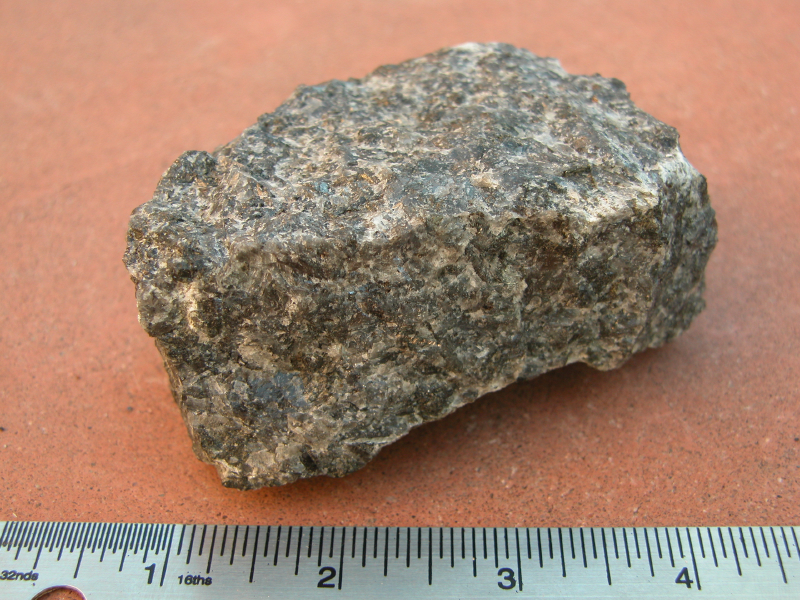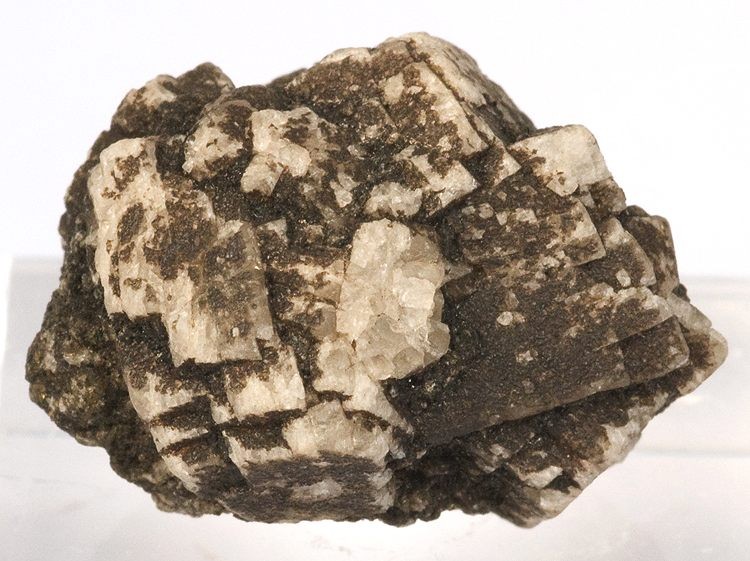|
Nepheline-bearing Gabbro
Nepheline-bearing gabbro is an intrusive rock with a composition intermediate between gabbro and nepheline gabbro. It is defined in the QAPF classification as coarse-grained igneous rock in which feldspathoids makes up 0% to 10% of the QAPF mineral fraction and are predominantly nepheline; plagioclase Plagioclase is a series of tectosilicate (framework silicate) minerals within the feldspar group. Rather than referring to a particular mineral with a specific chemical composition, plagioclase is a continuous solid solution series, more pro ... makes up 90% or more of the total feldspar content; and the plagioclase is calcium-rich (% An > 50). References Plutonic rocks {{Petrology-stub ... [...More Info...] [...Related Items...] OR: [Wikipedia] [Google] [Baidu] |
Intrusive Rock
Intrusive rock is formed when magma penetrates existing rock, crystallizes, and solidifies underground to form '' intrusions'', such as batholiths, dikes, sills, laccoliths, and volcanic necks.Intrusive RocksIntrusive rocks accessdate: March 27, 2017.Igneous intrusive rocks, accessdate: March 27, 2017.Britannica.comintrusive rock , geology , Britannica.com accessdate: March 27, 2017. Intrusion is one of the two ways igneous rock can form. The other is extrusion, such as a volcanic eruption or similar event. An intrusion is any body of intrusive igneous rock, formed from magma that cools and solidifies within the crust of the planet. In contrast, an ''extrusion'' consists of extrusive rock, formed above the surface of the crust. Some geologists use the term plutonic rock synonymously with intrusive rock, but other geologists subdivide intrusive rock, by crystal size, into coarse-grained plutonic rock (typically formed deeper in the Earth's crust in batholiths or stocks) a ... [...More Info...] [...Related Items...] OR: [Wikipedia] [Google] [Baidu] |
Gabbro
Gabbro () is a phaneritic (coarse-grained), mafic intrusive igneous rock formed from the slow cooling of magnesium-rich and iron-rich magma into a holocrystalline mass deep beneath the Earth's surface. Slow-cooling, coarse-grained gabbro is chemically equivalent to rapid-cooling, fine-grained basalt. Much of the Earth's oceanic crust is made of gabbro, formed at mid-ocean ridges. Gabbro is also found as plutons associated with continental volcanism. Due to its variant nature, the term ''gabbro'' may be applied loosely to a wide range of intrusive rocks, many of which are merely "gabbroic". By rough analogy, gabbro is to basalt as granite is to rhyolite. Etymology The term "gabbro" was used in the 1760s to name a set of rock types that were found in the ophiolites of the Apennine Mountains in Italy. It was named after Gabbro, a hamlet near Rosignano Marittimo in Tuscany. Then, in 1809, the German geologist Christian Leopold von Buch used the term more restrictively in ... [...More Info...] [...Related Items...] OR: [Wikipedia] [Google] [Baidu] |
Nepheline Gabbro
Nepheline, also called nephelite (), is a rock-forming mineral in the feldspathoid groupa silica-undersaturated aluminosilicate, Na3 K Al4 Si4 O16, that occurs in intrusive and volcanic rocks with low silica, and in their associated pegmatites. It is used in glass and ceramic manufacturing and other industries, and has been investigated as an ore of aluminium. Description and properties Nepheline crystals are rare and belong to the hexagonal system, usually having the form of a short, six-sided prism terminated by the basal plane. The crystals appear to have more symmetry than they actually possess, but unsymmetrical etched figures produced artificially on the prism faces indicate that the crystals are hemimorphic and tetartohedral, the only element of symmetry being a polar hexad axis. Nepheline is found in compact, granular aggregates, and can be white, yellow, gray, green, or reddish. Its hardness on the Mohs scale is 5.5–6, and its specific gravity 2.60–2.65. It ... [...More Info...] [...Related Items...] OR: [Wikipedia] [Google] [Baidu] |
QAPF Classification
A QAPF diagram is a double ternary diagram which is used to classify igneous rocks based on mineralogic composition. The acronym QAPF stands for "Quartz, Alkali feldspar, Plagioclase, Feldspathoid (Foid)". These are the mineral groups used for classification in QAPF diagram. Q, A, P and F percentages are normalized (recalculated so that their sum is 100%). Origin QAPF diagrams were created by the International Union of Geological Sciences (IUGS): ''Subcommission on the Systematics of Igneous Rocks'' fostered by Albert Streckeisen (whence their alternative name: Streckeisen diagrams). Geologists worldwide accept the diagrams as a classification of igneous, especially plutonic rocks. Usage QAPF diagrams are mostly used to classify plutonic rocks (phaneritic rocks), but are also used to classify volcanic rocks if modal mineralogical compositions have been determined. QAPF diagrams are not used to classify pyroclastic rocks or volcanic rocks if modal mineralogical composition is no ... [...More Info...] [...Related Items...] OR: [Wikipedia] [Google] [Baidu] |
Igneous Rock
Igneous rock (derived from the Latin word ''ignis'' meaning fire), or magmatic rock, is one of the three main rock types, the others being sedimentary and metamorphic. Igneous rock is formed through the cooling and solidification of magma or lava. The magma can be derived from partial melts of existing rocks in either a planet's mantle or crust. Typically, the melting is caused by one or more of three processes: an increase in temperature, a decrease in pressure, or a change in composition. Solidification into rock occurs either below the surface as intrusive rocks or on the surface as extrusive rocks. Igneous rock may form with crystallization to form granular, crystalline rocks, or without crystallization to form natural glasses. Igneous rocks occur in a wide range of geological settings: shields, platforms, orogens, basins, large igneous provinces, extended crust and oceanic crust. Geological significance Igneous and metamorphic rocks make up 90–95% of the top ... [...More Info...] [...Related Items...] OR: [Wikipedia] [Google] [Baidu] |
Feldspathoid
The feldspathoids are a group of tectosilicate minerals which resemble feldspars but have a different structure and much lower silica content. They occur in rare and unusual types of igneous rocks, and are usually not found in rocks containing primary quartz. A notable exception where feldspathoids and quartz-bearing rocks are found together is the Red Hill Syenite. Foid, a contraction of the term ''feldspathoid'', is applied to any igneous rock containing up to 60% modal feldspathoid minerals. For example, a syenite with significant nepheline Nepheline, also called nephelite (), is a rock-forming mineral in the feldspathoid groupa silica-undersaturated aluminosilicate, Na3 K Al4 Si4 O16, that occurs in intrusive and volcanic rocks with low silica, and in their associated pegmatit ... present can be termed a ''nepheline-bearing syenite'' or ''nepheline syenite'', with the term ''nepheline'' replaceable by any foid mineral. Such terminology is used in the Streckeisen ( QAPF) ... [...More Info...] [...Related Items...] OR: [Wikipedia] [Google] [Baidu] |
Nepheline
Nepheline, also called nephelite (), is a rock-forming mineral in the feldspathoid groupa silica-undersaturated aluminosilicate, Na3 K Al4 Si4 O16, that occurs in intrusive and volcanic rocks with low silica, and in their associated pegmatites. It is used in glass and ceramic manufacturing and other industries, and has been investigated as an ore of aluminium. Description and properties Nepheline crystals are rare and belong to the hexagonal system, usually having the form of a short, six-sided prism terminated by the basal plane. The crystals appear to have more symmetry than they actually possess, but unsymmetrical etched figures produced artificially on the prism faces indicate that the crystals are hemimorphic and tetartohedral, the only element of symmetry being a polar hexad axis. Nepheline is found in compact, granular aggregates, and can be white, yellow, gray, green, or reddish. Its hardness on the Mohs scale is 5.5–6, and its specific gravity 2.60–2.65. ... [...More Info...] [...Related Items...] OR: [Wikipedia] [Google] [Baidu] |
Plagioclase
Plagioclase is a series of tectosilicate (framework silicate) minerals within the feldspar group. Rather than referring to a particular mineral with a specific chemical composition, plagioclase is a continuous solid solution series, more properly known as the plagioclase feldspar series. This was first shown by the German mineralogist Johann Friedrich Christian Hessel (1796–1872) in 1826. The series ranges from albite to anorthite endmembers (with respective compositions NaAlSi3O8 to CaAl2Si2O8), where sodium and calcium atoms can substitute for each other in the mineral's crystal lattice structure. Plagioclase in hand samples is often identified by its polysynthetic crystal twinning or 'record-groove' effect. Plagioclase is a major constituent mineral in the Earth's crust, and is consequently an important diagnostic tool in petrology for identifying the composition, origin and evolution of igneous rocks. Plagioclase is also a major constituent of rock in the hi ... [...More Info...] [...Related Items...] OR: [Wikipedia] [Google] [Baidu] |
Anorthite
Anorthite is the calcium endmember of the plagioclase feldspar mineral series. The chemical formula of pure anorthite is Ca Al2 Si2O8. Anorthite is found in mafic igneous rocks. Anorthite is rare on the Earth but abundant on the Moon. Mineralogy Anorthite is the calcium-rich endmember of the plagioclase solid solution series, the other endmember being albite (NaAlSi3O8). Anorthite also refers to plagioclase compositions with more than 90 molecular percent of the anorthite endmember. At standard pressure, anorthite melts at .J.R. Goldsmith (1980): The melting and breakdown reactions of anorthite at high pressures and temperatures. Am. Mineralogist. 65, 272-284, http://www.minsocam.org/ammin/AM65/AM65_272.pdf Occurrence Anorthite is a rare compositional variety of plagioclase. It occurs in mafic igneous rock. It also occurs in metamorphic rocks of granulite facies, in metamorphosed carbonate rocks, and corundum deposits. Its type localities are Monte Somma and Valle di Fa ... [...More Info...] [...Related Items...] OR: [Wikipedia] [Google] [Baidu] |





